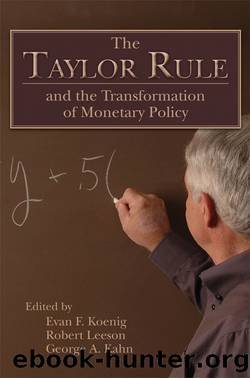The Taylor Rule and the Transformation of Monetary Policy by Leeson Robert;Koenig Evan F.;Kahn George A.; & Robert Leeson & George A. Kahn

Author:Leeson, Robert;Koenig, Evan F.;Kahn, George A.; & Robert Leeson & George A. Kahn
Language: eng
Format: epub
Tags: Taylor Rule, Ben Bernanke, John Taylor, economics, Federal Reserve, monetary policy, staggered wage, price setting, stabilization, lending rates, inflation, central bank, macroeconomics
Publisher: Hoover Institution Press
Published: 2012-05-31T00:00:00+00:00
REFERENCES
Ahmed, Shaghil, Andrew Levin, and Beth Anne Wilson. 2002. âRecent U.S. Macroeconomic Stability: Good Policies, Good Practices, or Good Luck?â Board of Governors of the Federal Reserve System, International Finance Discussion Paper 2002-730 (July).
Albanesi, Stefania, V. V. Chari, and Lawrence Christiano. 2003. âExpectation Traps and Monetary Policy.â Federal Reserve Bank of Minneapolis, Research Department Staff Report 319 (August).
Barsky, Robert, and Lutz Kilian. 2001. âDo We Really Know That Oil Caused the Great Stagflation? A Monetary Alternative.â In NBER Macroeconomics Annual, eds. Ben Bernanke and Kenneth Rogoff, 137â82. Cambridge, MA: MIT Press for the National Bureau of Economic Research (NBER).
Bernanke, Ben. 2003. â âConstrained Discretionâ and Monetary Policy.â Remarks before the Money Marketeers of New York University, New York, February 3.
âââ. 2004. âFedspeak.â Remarks at the meetings of the American Economic Association, San Diego, California, January 3.
Blanchard, Olivier, and John Simon. 2001. âThe Long and Large Decline in U.S. Output Volatility.â Brookings Papers on Economic Activity 1: 135â64.
Bullard, James, and Stefano Eusepi. 2003. âDid the Great Inflation Occur Despite Policymaker Commitment to a Taylor Rule?â Federal Reserve Bank of Atlanta, working paper 2003â20 (October).
Chatterjee, Satyajit. 2002. âThe Taylor Curve and the Unemployment-Inflation Tradeoff.â Federal Reserve Bank of Philadelphia Business Review (3rd quarter): 26â33.
Clarida, Richard, Jordi GalÃ, and Mark Gertler. 2000. âMonetary Policy Rules and Macroeconomic Stability: Evidence and Some Theory.â Quarterly Journal of Economics 115: 147â80.
Cogley, Timothy, and Thomas Sargent. 2002. âDrifts and Volatilities: Monetary Policies and Outcomes in the Post-WWII U.S.â Working paper, Arizona State University and New York University (August).
DeLong, J. Bradford. 1997. âAmericaâs Peacetime Inflation: The 1970s.â In Reducing Inflation: Motivation and Strategy, eds. Christina Romer and David Romer. Chicago: University of Chicago Press for NBER.
Devereux, Michael, Charles Engel, and Peter Storgaard. 2003. âEndogenous Exchange-Rate Pass-through when Nominal Prices Are Set in Advance.â National Bureau of Economic Research working paper 9543 (March).
Evans, George, and Seppo Honkapohja. 2001. Learning and Expectations in Macroeconomics. Princeton, NJ: Princeton University Press.
Friedman, Milton. 1968. âThe Role of Monetary Policy.â American Economic Review 58 (March): 1â17.
Gagnon, Joseph, and Jane Ihrig. 2002. âMonetary Policy and Exchange-Rate Passthrough.â Board of Governors of the Federal Reserve System, International Finance Discussion Paper 2001-704 (latest version March 2002).
Goodfriend, Marvin. 1993. âInterest Rate Policy and the Inflation Scare Problem, 1979â1992.â Federal Reserve Bank of Richmond Economic Quarterly 1 (Winter):1â23 (on the Federal Reserve Bank of Richmond Web site).
Judd, John, and Glenn Rudebusch. 1998. âTaylorâs Rule and the Fed: 1970â1997.â Federal Reserve Bank of San Francisco Economic Review 3:3â16.
Kahn, James, Margaret McConnell, and Gabriel Perez Quiros. 2002. âOn the Causes of the Increased Stability of the U.S. Economy.â Federal Reserve Bank of New York Economic Policy Review 8:183â202.
Kim, Chang-Jin, and Charles Nelson. 1999. âHas the U.S. Economy Become More Stable? A Bayesian Approach Based on a Markov-Switching Model of the Business Cycle.â Review of Economics and Statistics 81:608â16.
Kim, Chang-Jin, Charles Nelson, and Jeremy Piger. 2003. âThe Less Volatile U.S. Economy: A Bayesian Investigation of Timing, Breadth, and Potential Explanations.â Journal of Business and Economic Statistics, forthcoming. [JBES 22(2004): 80â93.]
Lansing, Kevin. 2002. âLearning about a Shift in Trend Output: Implications for Monetary Policy and Inflation.
Download
This site does not store any files on its server. We only index and link to content provided by other sites. Please contact the content providers to delete copyright contents if any and email us, we'll remove relevant links or contents immediately.
HBRâs 10 Must Reads for Executive Teams (with bonus article âLeadership That Gets Resultsâ by Daniel Goleman) (for True Epub) by Harvard Business Review(458)
Python for Finance Cookbook by Lewinson Eryk;(438)
Empowering Public Speaking by Deanna L. Fasset & Keith Nainby(402)
Doing business with Japan : successful strategies for intercultural communication by Kazuo Nishiyama(385)
Global Orders and Civilizations : Perspectives from History, Philosophy and International Relations by Sadik Unay; Muzaffer Senel(317)
Engaging with Ethics in International Criminological Research by Michael Adorjan Rose Ricciardelli(278)
The Future Internet by Bernard Marr(254)
Analysis of Financial Statements by Frank J. Fabozzi & Frank J. Fabozzi(253)
Intentional Power: The 6 Essential Leadership Skills For Triple Bottom Line Impact by Lisen Stromberg & JeanAnn Nichols & Corey Jones(253)
The Economics of Banking by Jin Cao(245)
The Three Skills of Top Trading by Hank Pruden(245)
Entrepreneurial Marketing by unknow(235)
The Oxford Handbook of Banking and Financial History by Youssef Cassis;Richard S. Grossman;Catherine R. Schenk;(231)
Focus on Teaching by Jim Knight(229)
Data Science and Analytics for SMEs: Consulting, Tools, Practical Use Cases by Afolabi Ibukun Tolulope(215)
Building a Career in Cybersecurity: The Strategy and Skills You Need to Succeed by Yuri Diogenes(215)
Financial Statement Analysis by Martin S. Fridson;Fernando Alvarez; & Fernando Alvarez(212)
New India by Arvind Panagariya(210)
Maximum Success with LinkedIn by Dan Sherman(187)
